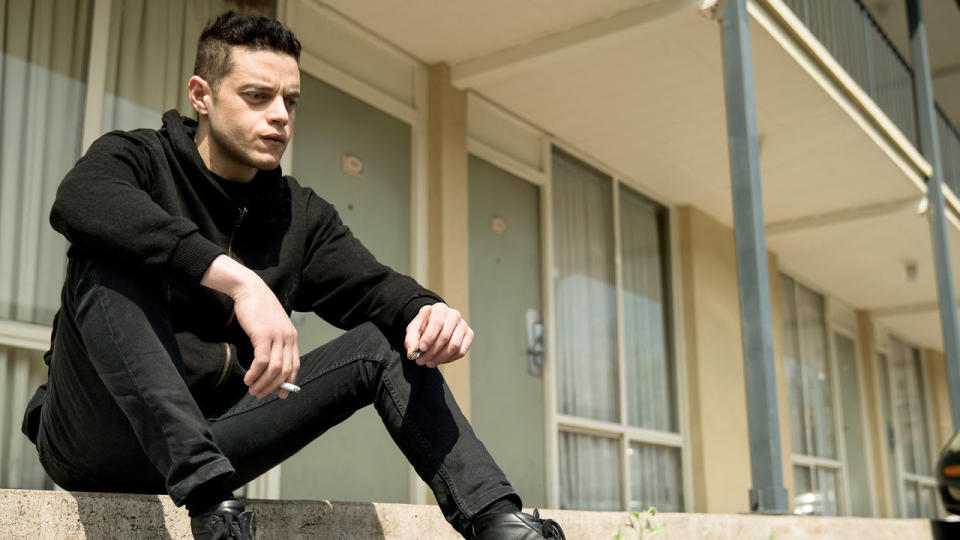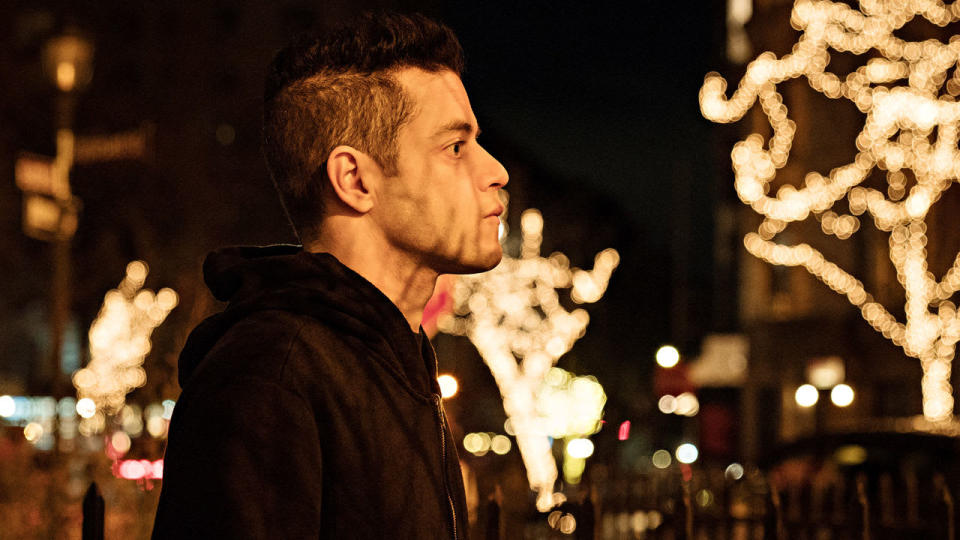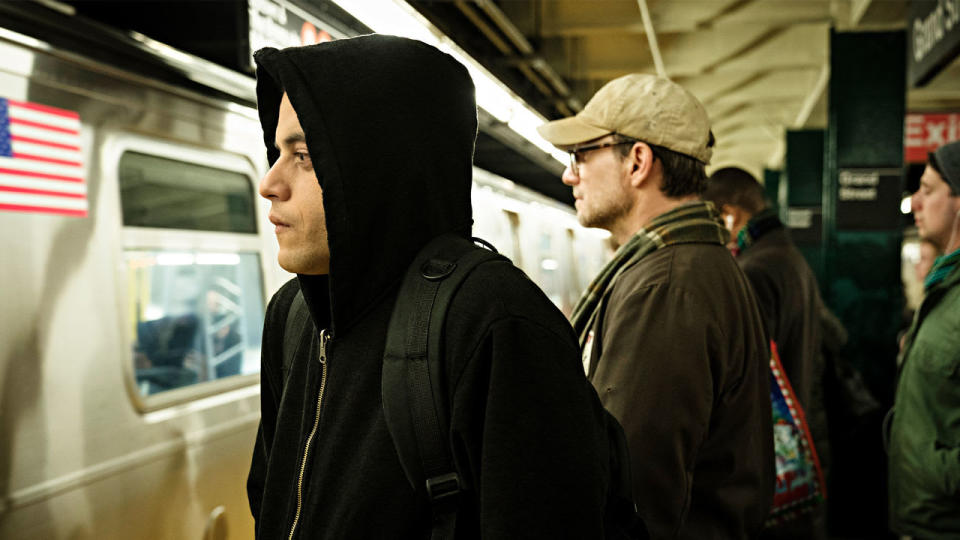Techno-thriller 'Mr. Robot' ends on a mind-melting high
Elliot's heartbreaking trauma and competing personalities outshine the authentic hacks.
- Oops!Something went wrong.Please try again later.
- Oops!Something went wrong.Please try again later.
(This article contains spoilers for 'Mr. Robot' season four)
When Mr. Robot debuted in June 2015, it was the show's commitment to authentic hacking that attracted eyeballs. For so long, cybersecurity had been shortchanged on-screen -- an ever-changing field that needed to be simplified, producers thought, for mainstream audiences and dramatic pacing. Mr. Robot was unique in part because it veered in the other direction, embracing the skill and complexity of modern-day hacking and taking time -- exponentially more than the average TV drama, anyway -- to explain the vulnerabilities that were being exploited and the knowledge or leverage it would give each character.
Hacking, though, was never the central theme of the show. Not really.
The final season of Sam Esmail's acclaimed techno-thriller crystalized what fans have long suspected: that the show is, and always was, about the link between hero Elliot Alderson and a bespectacled hacker wearing a frayed Mr. Robot patch on his jacket.

From the jump, it was obvious that Elliot was a complicated hero. The introverted New Yorker would often talk directly to the audience -- calling them a "friend" -- and explain his fractured relationships and Batman-esque vigilante work in long, brooding monologues. Dressed almost exclusively in black, he was a social outcast with the drive and technological ability to crush anyone, from coffee shop owners to conglomerate executive, hiding a criminal or simply immoral second life.
In the first season, the show revealed that Mr. Robot, the leader of a powerful hacker group called Fsociety, was actually part of Elliot's psyche. A mysterious force that could talk with the hero privately or, more alarmingly, send him into a memory-blocking stupor and take control of his body. The puzzling entity looked like Edward Alderson, Elliot's deceased father and the former owner of a computer store called Mr. Robot. In another shocking twist, Elliot discovered -- or rather, remembered -- that fellow Fsociety member Darlene was his sister.
These revelations proved that Elliot was an unreliable narrator. A flawed character that pushed forward by burying, compartmentalizing and occasionally rewriting some of his most painful and important memories.

The middle two seasons explored an internal power struggle and eventual truce between Elliot and Mr. Robot. Through it all, the audience was led to believe that Elliot -- not Mr. Robot or anybody else -- was the one 'true' personality that deserved full control, or at least the deciding vote, in everything his body did day-to-day.
Esmail kept some mind-melting revelations for the fourth and final season, though. Elliot, for instance, wasn't pushed out of his bedroom window as a child. "He kept shoving me away," Elliot told Mr. Robot in season one. "He shoved me so hard that I fell backwards out the window." During an impromptu therapy session, though, Elliot recalled that he jumped to escape a father who had sexually molested him growing up. He then created Mr. Robot as an imaginary 'protector' against this abuse and other "intolerable situations" he faced after his death.
Whiterose, the villainous leader of the Dark Army hacker group, offered Elliot an alternate reality to escape to. For the last couple of seasons, the show has teased -- worryingly, for many fans that didn't want the story to veer into hard sci-fi -- that Whiterose was on the verge of developing a time machine or some kind of portal between worlds. And for a moment, it looked like Esmail was following The Man in the High Castle's reality-hopping lead. Elliot, after all, seemingly died in Whiterose's secret facility and awoke in a vastly superior dimension where his father was still alive -- and more importantly, not a monster. He was also the CEO of a cybersecurity firm, sociable, and on the verge of marrying his best friend.

The world wasn't perfect, though. For one, Darlene didn't exist. And there were two Elliots -- the one the audience knows, and the one currently living a seemingly idyllic life. After an earthquake rippled through New York, our Elliot decided to kill his alternate reality equivalent and step into his life, believing that it was the only shot he had at true happiness. But Mr. Robot appeared and finally revealed the truth to Elliot: he wasn't in a parallel world, but a dream-like prison designed to contain Elliot Alderson's long-hidden personality.
Yep, that's right. The version of Elliot we've known since the start is actually a spin-off identity, just like Mr. Robot. In another dream sequence, Elliot's therapist explained that he was the "Mastermind," an angry and rage-filled personality that appeared just before the start of the show. He founded Fsociety and Elliot's protector, Mr. Robot, presumably helped because he thought it would purge all the evil in the world and, therefore, keep his creator as safe as humanly possible.
"You loved him so much, you wanted to save the entire world so you could make it better for him no matter the cost," the spiritual version of Krista said. "That's why you hid him here and turned his harsh reality into a fantasy."
It was an unexpected, but riveting twist that felt earned.

Throughout the show, Elliot saw two other figures -- his mother and a childhood version of himself -- occasionally re-enacting what appeared to be scenes from his childhood. The mother was a "persecutor" personality, the dream-like Krista explained, that haunted Elliot and blamed him for the abuse he received as a child. The younger version of Elliot, meanwhile, was meant to handle the abuse that he couldn't tolerate alone. "And with that, [Elliot] had created his own family of sorts," Krista explained in the finale.
During this sequence, the therapist also confirmed the existence of the audience -- known simply as voyeurs -- who watched Elliot from a distance.
Following this conversation, the Mastermind woke up in the real world and explained his true identity to Darlene. "I'm not him," he said. "Darlene, I'm not Elliot. I'm only a part of him." In response, Darlene admitted she had known he was a different personality since the early days of Fsociety. "I know you're not him," she said. "Not the Elliot I grew up with, at least." The show ended with Elliot's four hidden personalities -- the Mastermind and Mr. Robot, as well as Elliot's mother and younger self -- standing in a room high above New York City. "We'll always be a part of him, kiddo," Mr. Robot says before everyone walks out of the room, down a corridor and into a small theater that represents Elliot's subconsciousness.

The fourth season had some spectacular and imaginative hacking sequences that portrayed Elliot and Darlene as Robin Hood figures. But it was telling that you didn't see a single line of code in the final episode. There was no 'race against the clock' to find a world-saving loophole or vulnerability. No final chase to steal someone's phone or destroy a server cabinet. Instead, the show spent its final hours unpacking Elliot, his life, and the relationships he forged with, well, the various parts of himself.
It was a risky and unexpected finale that I'll always be grateful for. Mr. Robot will always be remembered for its heroic hacks and technological authenticity, but the show deserves just as much praise, if not more, for its exploration of a troubled human mind.



